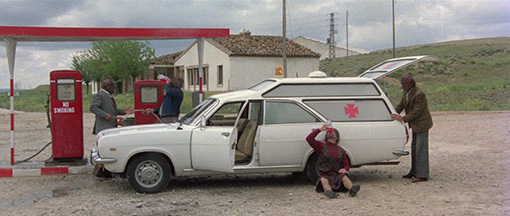|
When politically principled and fashion-unconscious TV reporter Dean Miller (played by Mexican actor and Rene Cardona Jnr. favourite Hugo Stiglitz) turns up for work one morning, he's sent to the airport to cover the arrival of a certain Professor Hagenbeck in order to interview him about a recent nuclear spillage that is hitting the headlines. He's told to take one of the station's best cameramen with him, but I'm guessing they were all busy or hiding under their desks, as I lost count of the number of times the amiable young dude who inherits the task stands and watches when he should have been eagerly filming. As the pair arrive at the airport, a military transport plane that refuses to respond to calls from the control tower comes in to land with no obvious sign that there's anyone on board. As military personnel gather round and tactfully ignore the presence of Miller and his hesitant cameraman, Professor Hagenbeck emerges and promptly stabs the officer who has stepped forward to meet him. He's immediately followed by a band of wild-eyed men with radiation-burn faces, who launch an all-out assault on the assembled soldiers. Despite being armed with machine guns, the military men are slaughtered by this manic and seemingly bullet resistant group of blade-wielding ghouls, who hungrily drink blood from the wounds they inflict. Luckily they completely ignore Dean and his cameraman, who after watching on for long enough for the horror to soak in, beat a hasty but hardly panic-stricken retreat.

In spite of my flip comments, this is one hell of an opening, a no-holds-barred explosion of aggression, violence and kinetic camerawork, and it's all Cannibal Ferox director Umberto Lenzi needs to get the ball rolling. Think about it. A band of infected humans with Herculean strength and a rabid craving for blood have landed on what we presume is supposed to be American soil (it's never really confirmed) and they're on the rampage. What more do you need to know? As the story unfolds we're invited to engage with Miller as he flees the countrywide mayhem with his surgeon wife Anna (Laura Trotter), and to listen to military head honcho General Murchison (Mel Ferrer), who once ensconced never leaves his windowless command centre and actually seems to do bugger all to alleviate the crisis. Also on the radar is Murchison's second-in-command Major Holmes (Francisco Rabal) and his attractive young wife Sheila (Maria Rosaria Omaggio), an aspiring sculptress (don't give up the day job) whom the ghouls seem to enjoy toying with instead of openly assaulting.
The 1980 Nightmare City was released in the US as City of the Walking Dead, a hugely misleading title given that the monsters in question are not technically dead and rarely slow down to anything like walking speed. Indeed, while the film has been credited as sporting cinema's first fast-moving zombies, in common with the contaminated creatures in 28 Days Later these are not resurrected corpses but the infected living. It's this that gives these creatures a serious edge in what has since become a wearily overcrowded field. By combining key characteristics of zombies and vampires into a single genetically messed-up entity, Lenzi creates humanoid monsters that are strong, hard to kill, quick on their feet, have a crazed thirst for blood, infect those they feed on, and act on instinct with no regard for their own safety. But they've also retained some of the smarts they had in their original uncontaminated form and thus do not stumble blindly towards their victims but methodically assault them like a band of murderous thugs. They also remember how to use weapons and go into action waving knives, sticks, garden scythes or anything else they can lay their hands on. Shove a blade into one of them and they'll pull it straight out and make use of it against you in a counter-attack. Drop a submachine gun and one of them will grab it and spray you and your comrades with a hail of bullets. Shutting yourself in a car à la The Walking Dead will do you no good because these guys know how to open doors. A few of them seem to take a sadistic glee in poking holes in their human targets, and a couple even tear the clothes off of women to make sure of inflicting a nice clean wound. At least I'm guessing that's their reasoning...

In many ways Nightmare City conforms to the Italian exploitation horror archetype. The acting is uneven, the cast multinational, the plot liberally peppered with logic holes, the subtext gossamer thin, the violence bloody, and women seem to suffer more horribly than men. The makeup effects are surprisingly rationed, restricted to a string of retractable blade stabs, some post-attack wounds, the odd exploding head shot and same not too convincing flesh slicing. The most contentious of these – a ghoul cuts off the nipple of a female victim to drink her blood from there – is so blatant in its Freudianism that it's almost worth being offended by. The score by the insanely prolific Stelvio Cipriani has Goblin-esque elements and I actually preferred it to many of Goblin's more prog-rock driven scores, and despite director Lenzi's claim that he's never seen "the George Romero movie," there are a couple of sequences here that wear a Dawn of the Dead influence like a rainbow-coloured waistcoat. Then again, a couple of viewings of Nightmare City may well prompt you to reconsider what the key influences were on the aforementioned 28 Days Later.
Surprisingly, given the film's country of origin, the Italian dub is often an even bigger mismatch to the actor's mouths than its English equivalent, on which the English-speaking Mel Ferrer comes off the best. Not that it matters. Wobbly dubbing is something that us fans of Italian horror cinema have long ago learned to live with and even rather enjoy. The ending is likely to prompt a few howls of disbelief, even if it is signalled to a degree by the title and borrowed from an older British horror work of note. But it fails to detract from the film's unwaveringly brisk pace, it's oddly effective sense of scale, the violent energy and choreography of the ghoul attacks, and the creepiness of arming your zombie-like monsters with negative emotions and problem-solving skills. And despite the stern expressions and gag-free dialogue, the film is not without its moments of wit, as evidenced by the ghouls who wipe their mouths on their sleeves after feeding off their victims, or the party of creatures glimpsed sitting around an ambulance swigging bottles of blood like a group of old pals on a hunting trip.
Now this is interesting. When Arrow undertook their restoration of Nightmare City from the original Techniscope negative, they discovered that sections of it had suffered chemical damage so severe that it was beyond repair. They also had access to a 4-perf reversal dupe negative that was in better condition, but did not consider it to be of acceptable quality for an HD restoration, being noticeably less sharp than the transfer from the original negative. So which to use for this dual format release? In a decision I have to loudly applaud, Arrow had chosen to include both transfers and leave it up to us to select which one we want to watch. Both have undergone extensive restoration, and while the chemical damage on the original negative is quite alarming in places and can hang around for minutes at a time, the superior sharpness, more finely balanced contrast and colour rendition make this the one to go for. At its best it looks terrific and is well up to Arrow's impeccably high standards, and chemical damage aside is largely clean of dust and damage. But it's great to have the option to view the alternative transfer – if your screen is small enough it may well suffice.

One of the more severely damaged shots (above), but
below
is an example of how good the rest of it looks.

The Linear PCM 2.0 mono soundtracks are in solid shape, a tad range restricted, but the music and the more aggressive sound effects come across well. There are no signs of damage of background hiss or crackle. You can select between English and subtitled Italian dubs, and as I inferred above I preferred the English track, in part because of its nostalgia factor – this is how most of us saw and heard these films when they were first released.
English translation subtitles accompany the Italian language track (they are activated automatically if you select that track), and optional English subtitles for the deaf and hearing impaired are also available.
Umberto Lenzi Interview (28:41)
The fast-talking and seemingly pause-allergic Lenzi claims up front to never have seen "the George Romero movie" (I'm guessing we're talking about Dawn of the Dead here) but clearly respects it, so much so that he rejected the idea of making a straight zombie film because whatever he did would be secondary to Romero's achievements. He outlines how the project came to be and talks about the key players, about whom he is sometimes unexpectedly forthright, claiming that Hugo Stiglitz was not a very good actor and that Laura Trotter didn't have much talent, though he thought she was good here. Info on where the film was shot is supplied, and there's an enjoyable anecdote about the method he employed to secretly film American military planes. There's also a fair amount on Tom Savini's proposed remake, which is currently in the process of raising a crowd-funded budget. There's plenty more to get your teeth into here. It's conducted in Italian with clear English subtitles.
Maria Rosaria Omaggio Interview (7:41)
Actress Maria Rosaria Omaggio, still looking seductive 35 years on and sporting a gorgeously deep and velvety voice, recalls working with Spanish actor Franciso Rabal and the experience of being naked on screen, and reveals that she really doesn't like horror movies and has thus never watched Nightmare City. Omaggio speaks in heavily accented English, which I personally had no problem at all understanding, but English subtitles are supplied anyway.

Eli Roth on Nightmare City (10:33)
Director and enthusiastic ambassador for the horror genre Eli Roth takes us on a quick trip through some of the Lenzi movies from his DVD collection before focussing exclusively on Nightmare City, which is one of his favourite films. He gives a plausible reason for the lack of sync sound in Italian movies that I've not been able to verify, salutes the work of score composer Stelvio Cipriani, and suggests that while some movies are healthy, this one is more like fast food – pure entertainment.
The Limits of Restoration (4:34)
A text and image-driven extra that is boldly up front about the damage to the negative and the differences between the transfer struck from that source and the once made from dupe reversal negative. It also explains the difference between Techniscope and anamorphic systems like Panavision and Cinemascope so clearly that it should be part of the curriculum of every film school in the world. While I'd normally suggest you save all extra features until after your first viewing of the film, this one I'd definitely watch beforehand, something the film encourages you to do by placing it up front on the opening sub-menu that allows you to select which version you want to play.
Original Trailer (3:45)
In Italian with English subtitles, but wearing the British title and English language credits, this loosely assembled sell does include some of the stronger violence and makeup effects, making me wonder just where it was shown.

Alternate Opening Titles (2:11)
An English language opening title sequence with the lettering in white rather than the oxygenated blood red on the Italian print. I was expecting this to bear the American title, City of the Walking Dead, but it's actually from a print bearing the somewhat cruder moniker Attack of the Zombies.
Audio Commentary with Chris Alexander
Fangoria editor Chris Alexander kicks off his lively and informal commentary track by assuring us that he's not talking here as an expert but as a fan of the film, which he loves despite his belief that it's not that great a movie. He makes the point that all film viewing experiences are subjective anyway (a view I happen to share) and that critics who claim otherwise can kiss his arse (sorry, "ass"). He does spend quite a bit of time pointing out of things that he believes make no sense, though in the process seems occasionally a little blind to the obvious, and he gets a little fixated on Hugo Stiglitz's beard. Intermittently these digs get a little annoying, and he lost serious points with me by combining two of the most infuriating current lingual tics in one sentence when he described one zombie as "super-awesome". But as with his commentary on the Arrow release of Contamination, there's plenty of good stuff here, and Alexander's enthusiasm is infectious.
Also on board is a glossy colour Booklet containing an essay on director Umberto Lenzi and Nightmare City by John Martin, author of Seduction of the Gullible: The Truth Behind the Video Nasty Scandal, detailed notes on the restoration, credits for the film, stills and reproduction of the American City of the Walking Dead poster.
A charged, no-nonsense twist on the post-Dawn of the Dead zombie formula that isn't actually a zombie movie at all. Those with a dislike for cash-in 80s Italian horror quickies, however inventive or energetic, need not apply – this is one for the genre fans, and in spite of its flaws and an ending that few will not groan at, it delivers in spades. Arrow really have done the right thing here when faced with an almost impossible dilemma over the negative damage, allowing us to choose which version we prefer, and as ever have backed it up with a fine collection of extra features. Recommended. |